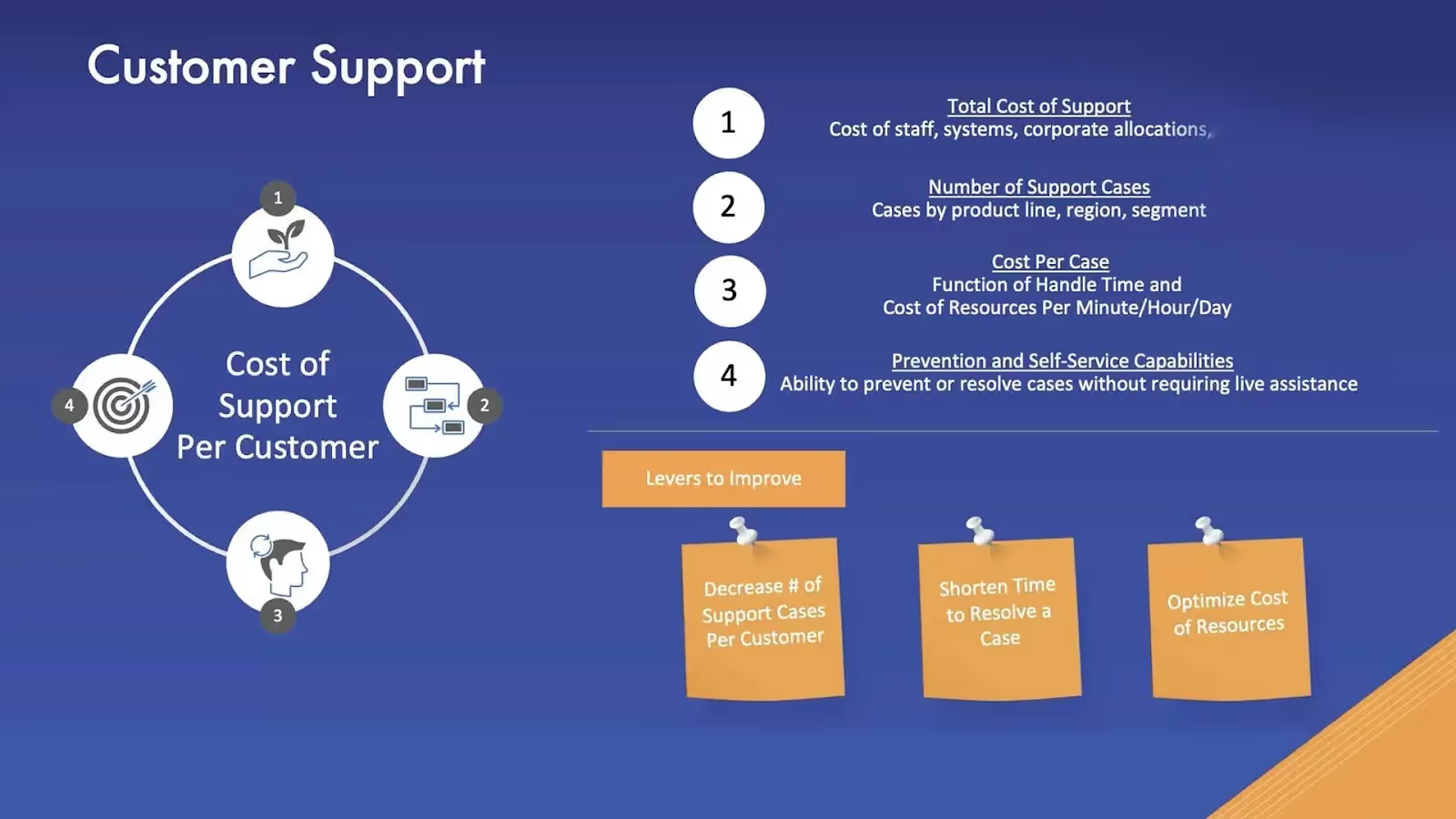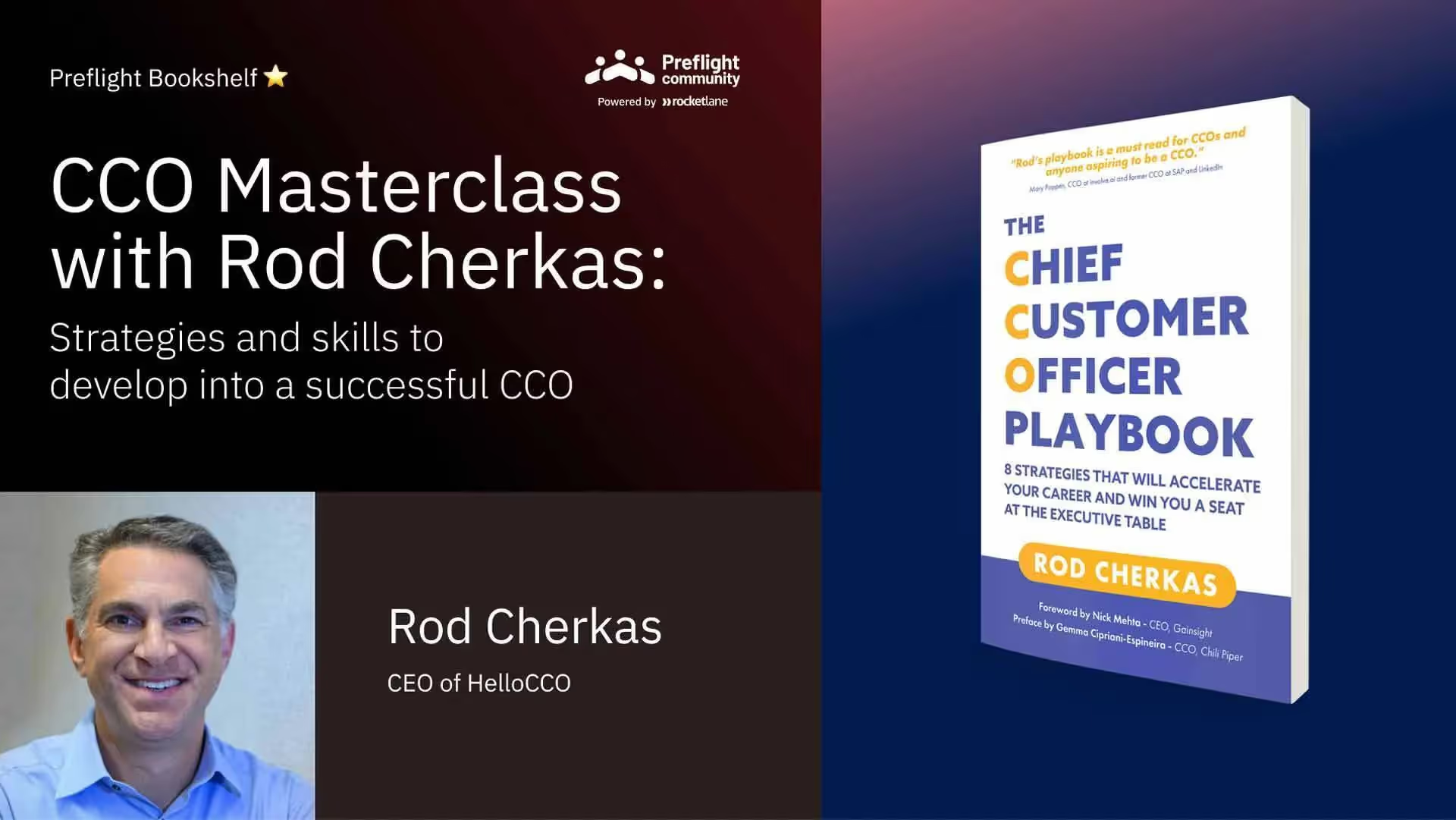Further reading
- The Post-Sale SCALING™ Framework: Rod Cherkas for Propel22
- 4 critical customer onboarding challenges and how to overcome them
- Planning your career path to Chief Customer Officer
The AI boom has brought about a lot of changes in organizations worldwide. While AI has made life easy for many people, it has also brought about a lot of imbalance in the careers of professionals.
Most companies operate with the same or smaller budget and resources, and the employees find it challenging to grow the company in such circumstances. A group of Preflighters expressed their concerns about how they feel they need to do more with limited resources, which can be overwhelming for professionals.
In this CCO Masterclass, Rod Cherkas, Strategy Consultant and Advisor to CCOs and post-sale leaders, explains how various tools and resources can be used to bring balance into a person’s career and work life, to be more in control of their situations.
Here are the topics that Rod talked about:
- Strategies for building skills relevant to your career
- Build a repository of resources from scratch
- ChatGPT: How to write a good prompt
- Demonstrating strategic thinking: Segmentation and differentiated experiences
Strategies for building skills relevant to your career
In his book ‘Chief Customer Officer Playbook’, Rod explains the set of skills and strategies that it takes to develop into a successful Chief Customer Officer (CCO). He discusses three main strategies that help in bringing balance and building skills that can be relevant to your career. We shall look into each of these points in detail. Let’s begin.
1. Optimizing metrics that matter
As a leader, it is crucial that you understand and clearly define the success metrics and key performance indicators for your organization. You should consistently track these metrics to demonstrate how well your group is performing.
It is important to familiarize yourself with the numbers and operations of your business, as well as understand the key factors that drive success.
In today's business landscape, where revenue growth and profitability are paramount, it is vital for everyone to be able to illustrate how their work contributes to these objectives.
For example, if you are in charge of a services or customer onboarding team, you should be able to demonstrate how your efforts lead to revenue growth, accelerate revenue generation, create expansion opportunities, and foster customer advocacy.
Cost of delivery for software
It is highly important and beneficial for leaders like yourselves to establish a strong relationship with your finance manager, particularly your CFO. This will enable you to comprehend the financial aspects of your role and make informed decisions about your expenditures.
One valuable way to achieve this is by understanding your cost of delivery. This can be analyzed at a functional level, such as with an implementation or onboarding team, or across your entire organization.
Let's use the example of an implementation. You can assess the costs allocated for the implementation, including support costs, CSM team costs, operations, and other systems and tools. By accumulating these expenses, you can then divide them by the number of customers within that segment or your entire business.
This calculation will provide you with the cost of service to each customer. Earlier, when funds were readily available and interest rates were low, the careful investment in acquiring and supporting customers may not have been a top concern due to the abundance of capital.
However, in the current era where the value of money is increasing, it is imperative to contemplate your investments in this aspect carefully.
Customer Support
Another example that you can consider is the analysis of the cost of supporting a customer. You need to examine the inputs and the associated costs of providing service. Additionally, you should identify the strategies or methods that can be employed to allocate resources efficiently.
For instance, the objectives of a support organization could include reducing the number of tickets per customer or improving call handling speed to serve more customers with the same set of resources.
Here are some levers to improve your customer support function:
- Reduce the number of support cases for your customer
- Shorten time taken to resolve a customer ticket
- Optimize the cost of resources

Here are some career accelerators to become a successful CCO:
Understand your cost of delivery. Calculating the cost of delivery will help you obtain the cost of providing service to each individual customer.
Rod Cherkas offers a free downloadable template for calculating the Cost of Delivery for your business. This model can be used to fill in various details and assumptions, including the cost of services to consultants, education team members, and customer success managers.
It is important to note that these are not just salaries but also include bonuses, benefits, and corporate allocations. These serve as placeholders and provide a general understanding of costs. Consulting with the finance team will help determine the exact figures.
Work closely with your CFO or finance business partner. If you are not currently engaging in conversations with your CFO or finance business partner, scheduling a meeting and establishing regular discussions would be beneficial.
This is an excellent opportunity for learning. Understanding numbers and levers plays a significant role in your career success. Being able to translate your work into the language of your executive team helps you prioritize effectively.
Prioritize resource management.
Evaluate cost by segment or product.
2. Improve efficiency and productivity
User academies
Many companies invest a considerable amount of time in repeating the same training process for all their customers. They guide customers through the implementation process and provide step-by-step instructions on setting up and utilizing the solution.
However, even after the implementation phase is completed, the company often encounters new members in the customer's IT organization who require training on how to use their service.
Companies like Automox and Skilljar put together videos and resources to create learning paths tailored to different personas. The focus would not only be on teaching people how to use the capability, but also how to perform their jobs effectively.
This approach could be integrated into the customer onboarding process, eliminating the need for constant hand-holding from the implementation team. Instead, individuals could be directed to watch specific videos or access certain resources to gain a basic understanding before applying it within their organization. This would create a more repeatable training method.
Webinars
Webinars can benefit not only your smaller clients, who may not have a dedicated customer success manager or implementation team.
Webinars that are carefully planned and cover relevant topics attract enterprise clients as well. It assists them in learning and advancing their growth.
Best practices, use cases, and resources
Companies like SmartRecruiter offer various resources, including guidance on how to utilize their platform effectively. They go beyond that by advising on improving one's skills as a hiring manager or recruiter.
By offering these additional resources, you can foster a stronger connection with your customers and prospects.
Community
The concept of community is gaining popularity as a means of engaging with customers and providing them with the resources to help themselves. This includes facilitating the exchange of information and answers to questions among community members while ensuring user-friendliness across various interfaces.
Rocketlane, for instance, stands out for its Slack community, Preflight, and events that contribute to creating a scalable support system. These resources offer plenty of assistance without the need for direct interaction with staff.
Building a help center: documentation, screenshots, videos
The help center built by the company Vitally, which is a customer success platform, has a great layout and is user-friendly for their customers. Their documentation includes text, videos, and screenshots to guide users through the process step by step.
Vitally is a small company and doesn't have the resources to hire large implementation or customer success management teams. These companies understand the importance of scalability and have found ways to achieve it without relying on large teams or resources.
3. Build a repository of resources from scratch
If you lack the necessary skills for managing webinars, email campaigns, or building a community, it might be worth considering how you can collaborate with your marketing team. It's crucial for post-sale teams to work closely with marketing and customer marketing teams.
Sometimes, the customer marketing team should even report to the Chief Customer Officer or a similar role because their skill set is essential in developing scalable programs.
ChatGPT: How to write a good prompt
Preflighters shared their experience using ChatGPT. From generating questions to ask a candidate in an interview based on their specific field to discovering more about prospect companies to create better pitches. ChatGPT collects all the relevant information in a matter of seconds, while it would have taken someone around 60 minutes to collect the data manually.
However, some companies have implemented policies prohibiting the use of ChatGPT at work due to concerns about sharing sensitive information and the potential for unauthorized access to proprietary data. The ability to freely download transcripts from Gong into ChatGPT poses a risk of training external entities on confidential knowledge.
However, efforts are being made to develop a private version of chat GPT, similar to an intranet specifically designed for businesses. This would allow organizations to utilize chat GPT while maintaining data privacy and security.
With this solution, it will be possible to analyze internal information, such as customer feedback from net promoter scores or notes from churned customers, for valuable insights.
The capabilities of chat GPT are impressive and encourage companies to rethink how they approach their operations, considering more than just incremental improvements or cost reductions.
ChatGPT could provide a valuable starting point and a framework or draft to help you think about how you want to expand on it.
Here is an example. You are a Director of Implementation at an automotive company. You want to create a series of email campaigns for your customers on how to complete your onboarding and configuration. Here is how you can provide ChatGPT with prompts for the same to get the first draft of your campaign.
- Describe your role or persona: “I'm the director of implementation at a company.”
- Describe what your company does: “Our company makes marketing automation software for the automotive industry.”
- Describe what you want ChatGPT to do: “I want to create an onboarding stream of six emails to send to customers, one each week, to give them instructions on how to complete our onboarding and configuration.”
- Describe how you want to see your results: “I want to see this in an email.”
- Refine your results: Refine your results to suit your company’s needs better.
If you need help creating your first ChatGPT prompt, Rod Cherkas has created a resource with 250+ tips and ChatGPT prompts that can give you a headstart.
Demonstrate strategic thinking: Segmentation and differentiated experiences
Segmentation can help improve the productivity and efficiency of your teams by designing experiences tailored to different customer segments. It can be based on various factors, such as business size, regions, or business lines.
The key is to understand the unique needs of each segment and provide relevant services post-sale. By differentiating your offerings, you can meet the diverse requirements of your customers.
If you manage an implementation team, it is common for companies to adopt a one-size-fits-all approach. However, as your teams grow, this approach becomes impractical. Larger customers require more support and project management, while smaller customers prefer less attention.
You can create distinct onboarding models and approaches by identifying the characteristics of different customer segments. This enables optimal resource allocation and aligns the cost of delivery with the value provided by each segment.
In some cases, you may need highly skilled problem solvers for complex issues, while in others, a process handled by new employees may suffice. Consider factors like time expectations, project size, and required resources to fine-tune your segmentation strategy. Taking this approach can greatly benefit your business.
Here are some career accelerators to improve your segmentation:
- Align to company objectives
- Identify high-priority segments or customers
- Create differentiated experiences and offerings
- Reallocate your scarce resources
You can access Rod Cherkas’ customer experience-segmentation template to get started on your segmentation strategy.















